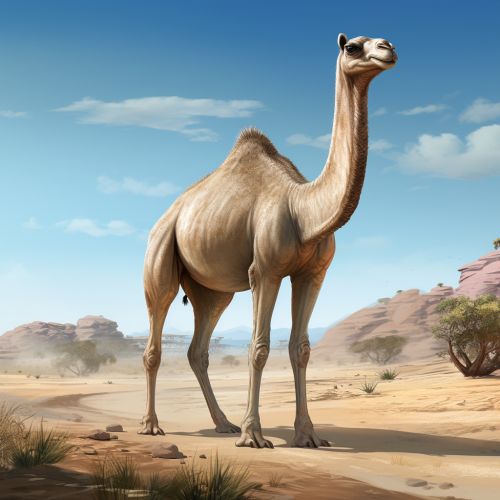Poebrotherium
Introduction
Poebrotherium is an extinct genus of camelids that existed during the middle Eocene to the early Oligocene epochs. The genus was first described by paleontologist Joseph Leidy in 1870. The name Poebrotherium translates to "grass-eating beast", reflecting the herbivorous diet of these animals.


Description
Poebrotherium was a small, slender animal that resembled a modern-day gazelle more than a camel. It had a long neck and short limbs, which were adapted for running. The body length of Poebrotherium was approximately 1.2 meters, with a shoulder height of about 60 centimeters. The weight of an adult Poebrotherium is estimated to have been around 30 kilograms.
The skull of Poebrotherium was elongated and narrow, with a relatively small braincase. The teeth were adapted for grinding plant material, indicating a herbivorous diet. The dental formula of Poebrotherium was similar to that of modern camels, with a total of 44 teeth.
Evolution
Poebrotherium is considered to be one of the earliest known members of the camelid family. It evolved from earlier artiodactyls during the Eocene epoch, around 40 million years ago. The evolution of Poebrotherium is closely tied to the development of grasslands in North America during this period.
The genus Poebrotherium is part of the subfamily Poebrotheriinae, which also includes the genera Oxydactylus and Protomeryx. These genera are collectively known as the "running camels", reflecting their adaptation to open habitats and a cursorial lifestyle.
Habitat and Behavior
Poebrotherium lived in the grasslands and open woodlands of North America. Fossil evidence suggests that it was a highly social animal, living in large herds. The herding behavior of Poebrotherium is thought to have been a strategy for protection against predators.
The diet of Poebrotherium consisted primarily of grasses and other low-growing plants. The teeth of Poebrotherium show wear patterns consistent with a diet of tough, abrasive plant material. This suggests that Poebrotherium was a grazer, rather than a browser.
Extinction
The extinction of Poebrotherium occurred during the early Oligocene epoch, around 30 million years ago. The cause of this extinction is not well understood, but it may have been related to changes in climate and vegetation patterns. The extinction of Poebrotherium marked the end of the Poebrotheriinae subfamily.
